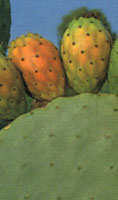View crop
View crop Data sheet EcoPortOpuntia ficus-indica
 |
|
| Notes |
|---|
| DESCRIPTION: Cactus pear is a perennial shrub up to 3 m tall and it is characterized by a shallow, fleshy root system with a horizontal spread. The stem-like organs (cladodes) are succulent and typically oblong to spatulate-oblong, 30-40 cm long (up to 70-80 cm) and 18-25 cm wide. In cross section it is an eustele with a skin, cortex, ring of vascular tissue made from collateral bundles separated by parenchyma and pith which is the major succulent tissue. The skin is one layer of epidermal cells with 6-7 layers of hypodermal cells with thick primary walls resembling a laminar collenchyma tissue. The epidermal cells are flat, thin and shaped like paving stones. This strong skin helps protect against pest and disease attack. The skin is eventually replaced by a periderm ("bark") formed from epidermal cells or from cortex tissue when injured. The bark breaks off when formed from hypodermis cells. The outermost wall of the epidermis, 8-20 mm thick, is impregnated with wax containing cutin making the skin surface very water repellent and retaining as well as reflecting the sun's rays. True leaves are not fully formed but are reduced to spines. When the cladode is young the areole forms at the podarium base and this has a green ephemeral structure (the 'leaf'); which soon withers and falls. Flowers develop in the upper part of 1- 2 year old cladodes and mostly open late morning. They consist of numerous fat sepals and many yellow, oval, pointed petals. The fruit is an oval or elongated berry weighing from 100-200 grams. It has a thick fleshy skin or rind; which is 30-40% of the total weight. Both mature fruits and spring flushes of new fruits may be found on the same cladode. Seeds are small and hard, the number per fruit varies from 80 to over 300 and are 5-10% of pulp weight. They have a hard lignified coat; which hinders germination. It utilizes the CAM path for photosynthesis. CAM plants are generally slow-growing, this is not the case for cactus pear. It is hermaphrodite, autogamous and actinomorphic with differentiation occurring within 2 months after meristem activity. Bees seem to be the major pollinators. USES: The principal uses are for food and feed. Others include hedging, erosion control, medicinal, cosmetic and dyes. The cactus pear features widely both in subsistence and niche market agriculture and particularly in semi-arid regions where it also plays a soil conservation role. It is cultivated in over 30 countries for its fruits, young cladodes (as vegetables) and mature cladodes for forage. Under optimal conditions 40 t/ha of dry matter can be achieved and fruit yields of up to 20 t/ha are feasible. A salad of ?nopalitos?, is one of the multiple ways that young cactus cladodes are traditionally consumed in Mexico. Dyes: The carmine cochineal develops on cladodes of the cactus pear. Both nymphs and adult females suck sap from the cladode but do not harm their host plant. The insects secrete a powdery, waxy covering; which protects them from their predators. The fully grown females are harvested and dried before extraction of carminic acid, an excellent natural red dye. NOTE: This cochineal species is not to be confused with the biological control agent, Dactylopius opuntiae which kills the cactus pear but does not produce high levels of carminic acid. Medicine: It has nutritive, diuretic, antispasmodic and emollient properties. GROWING PERIOD: Perennial shrub, growing 3 years before first harvest. KILLING TEMP.: When mature it is frost-hardy to -10oC for short periods. COMMON NAMES: Indian fig, Spineless cactus, Prickly pear, Tuna, Barbary fig, Cactus fruit, Cactus pear, Turksvy, Figue de barbarie, Indianische feige, Frucht des feigenkactus, Fico d'India, Figo da India, Figueira da India, Nopal, Chumbo, Chumbera. FURTHER INF.: Indian fig is native to tropical America. The national emblem of Mexico is an eagle perched on a cactus pear plant. According to legend an Aztec chief announced that he would build his capital where an eagle perched. The eagle caught a snake and perched on a cactus pear plant. Mexico City was built on that spot. It grows over a wide range of soils from vertisols, luvisols and feozem in Mexico to lithosols, regosols, cambisols and fluvisols in Italy. It is not salt-tolerant. It is drought resistant with one of the highest WUEs. A summer rainfall of 300-600 mm is sufficient. Multiplication is by vegetative propagation mainly using direct field planted single cladodes. Row orientation should be N-S to maximise radiation interception if topography permits. Rows 1-1.5 m wide and with an intra-row spacing of 0.25-0.5 m is common and 1700 plants/ha is the average population density for traditional plantation methods. Single or multiple cladodes are planted from 1-3 per hole. Weeding is essential as weeds efficiently compete with the shallow-rooted cactus pear for water and nutrients. Several types of pruning are used to enhance productivity, such as the vase and globe architecture. The fruits are delicate and careful hand harvesting is required. A small piece of the cladode is cut with the fruit for packing. |
Sources |
| FAO-Cactus (Opuntia spp.) as Forage USDA Plants Profile Roecklein J 1987 pp 220 [USE] Duke J 1975 pp 22 [PH, RAIN, TEMP] Hackett C 1982 pp 108 [FER, PHO, DEP, PH, TEXT, TEMP] Popenoe W 1974 pp 448-450 [TEXT, DEP, DRA] |